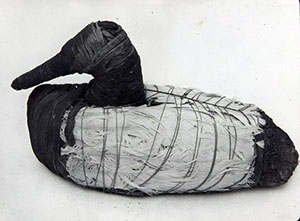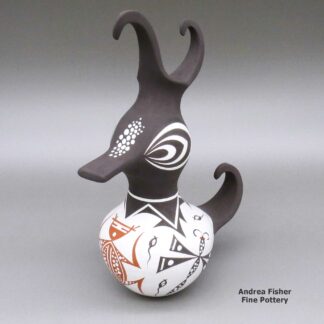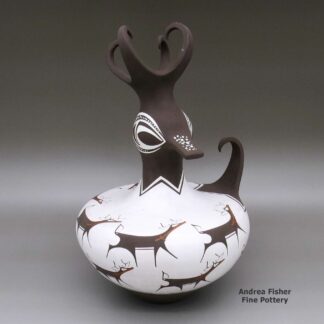Duck pot
About the Duck Pot

The "duck pot" is a form of effigy. The shape has a long history, stretching back thousands of years. In Nevada, near the Humboldt Sink (where the Humboldt River disappears into the desert sands), a group of guano miners working in Lovelock Cave in 1911 exposed some ancient artifacts while they were digging. Shortly after the miners left, some archaeologists arrived and started poking around and digging, too. They weren't much better educated in the practices of archaeological digging than the guano miners were but they did save almost everything they found. It was more than a decade after those archaeologists investigated the cave that other archaeologists dug a bit deeper in the back of the cave and found a bundle of eleven duck decoys, all woven of local reeds more than 2,300 years ago. Some were painted, some were decorated with feathers, some weren't finished yet.
In the excavations carried out in the abandoned Zuni pueblos (from before the arrival of the Spanish), the remains of several duck effigy pots were found (and spirited away to basements far away).
Modern duck pots are primarily made at either Zuni or Mata Ortiz. Generally they have a head (often with an elaborate crown) and body with stubby wings and a tail. No legs as ducks are generally imagined as if they were floating on water with their legs invisible.
Most contemporary Zuni duck pots are decorated with images of deer-with-heart-line, deer-in-his-house and the geometric symbols for forests and mountains. Some have images of tadpoles and frogs on them, some just geometric designs. All of them are homage to the beautiful and generous Pautiwa, Chief of the Zuni Kachinas. When Pautiwa travels, he assumes the form of a duck: a duck is easily mobile in all six directions and ducks always know where to find water.
Showing all 3 results
-

Anderson Jamie Peynetsa, zzzu3c030m1, Duck jar with geometric design
$850.00 Add to cart -

Anderson Peynetsa, zzzu2m144, Polychrome duck jar with deer-with-heart-line and geometric design
$375.00 Add to cart -

Anderson Peynetsa, zzzu3c033, Duck pot with deer-with-heart-line design
$1,900.00 Add to cart
Showing all 3 results